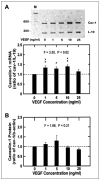Regulation of caveolin-1 expression and phosphorylation by VEGF in ovine amnion cells
- PMID: 20720263
- PMCID: PMC3965204
- DOI: 10.1177/1933719110378175
Regulation of caveolin-1 expression and phosphorylation by VEGF in ovine amnion cells
Abstract
Vascular endothelial growth factor (VEGF) has been implicated in the regulation of vesicular transport of amniotic fluid via caveolae across the amnion. This study tested the hypothesis that VEGF regulates caveolar function by stimulating caveolin-1 expression and phosphorylation in ovine amniotic epithelial cells (oAECs). Using primary cultures of oAECs, caveolin-1 was identified by immunofluorescent staining. Caveolin-1 messenger RNA (mRNA) abundance was determined by Reverse Transcription-Polymerase Chain Reaction (RT-PCR) and protein by Western blotting. The effects of VEGF( 165) on caveolin-1 expression and phosphorylation were determined. Caveolin-1 immunoreactivity was detected in oAECs. In response to 10 ng/mL VEGF( 165), caveolin-1 mRNA levels increased whereas the protein levels were unaffected. Furthermore, VEGF stimulated caveolin-1 phosphorylation, an effect abrogated by the inhibition of c-Src protein kinase. These data suggest that VEGF upregulates caveolin-1 activity through c-Src signaling pathways. Our observations support the hypothesis that VEGF regulates amniotic fluid transport across the amnion by stimulating caveolin-1 activity to mediate caveolar function in amnion cells.
Conflict of interest statement
The author(s) declared no conflicts of interest with respect to the authorship and/or publication of this article.
Figures




Similar articles
-
Retinoic Acid Pathway Regulation of Vascular Endothelial Growth Factor in Ovine Amnion.Reprod Sci. 2019 Oct;26(10):1351-1359. doi: 10.1177/1933719118765979. Epub 2018 Mar 27. Reprod Sci. 2019. PMID: 29587617 Free PMC article.
-
Transport-associated pathway responses in ovine fetal membranes to changes in amniotic fluid dynamics.Physiol Rep. 2017 Nov;5(20):e13455. doi: 10.14814/phy2.13455. Physiol Rep. 2017. PMID: 29051303 Free PMC article.
-
Prostaglandin E2 regulation of amnion cell vascular endothelial growth factor expression: relationship with intramembranous absorption rate in fetal sheep.Am J Physiol Regul Integr Comp Physiol. 2014 Aug 1;307(3):R354-60. doi: 10.1152/ajpregu.00070.2014. Epub 2014 Jun 4. Am J Physiol Regul Integr Comp Physiol. 2014. PMID: 24898841 Free PMC article.
-
Deciphering mechanisms controlling placental artery endothelial cell migration stimulated by vascular endothelial growth factor.Endocrinology. 2010 Jul;151(7):3432-44. doi: 10.1210/en.2009-1305. Epub 2010 May 12. Endocrinology. 2010. PMID: 20463056 Free PMC article.
-
Vascular endothelial growth factor activation of intramembranous absorption: a critical pathway for amniotic fluid volume regulation.J Soc Gynecol Investig. 2004 Feb;11(2):63-74. doi: 10.1016/j.jsgi.2003.09.002. J Soc Gynecol Investig. 2004. PMID: 14980307 Review.
Cited by
-
Pre-B cell colony enhancing factor (PBEF/NAMPT/Visfatin) and vascular endothelial growth factor (VEGF) cooperate to increase the permeability of the human placental amnion.Placenta. 2013 Jan;34(1):42-9. doi: 10.1016/j.placenta.2012.10.008. Epub 2012 Nov 12. Placenta. 2013. PMID: 23151382 Free PMC article.
-
Retinoic Acid Pathway Regulation of Vascular Endothelial Growth Factor in Ovine Amnion.Reprod Sci. 2019 Oct;26(10):1351-1359. doi: 10.1177/1933719118765979. Epub 2018 Mar 27. Reprod Sci. 2019. PMID: 29587617 Free PMC article.
-
Transport-associated pathway responses in ovine fetal membranes to changes in amniotic fluid dynamics.Physiol Rep. 2017 Nov;5(20):e13455. doi: 10.14814/phy2.13455. Physiol Rep. 2017. PMID: 29051303 Free PMC article.
-
Prostaglandin E2 regulation of amnion cell vascular endothelial growth factor expression: relationship with intramembranous absorption rate in fetal sheep.Am J Physiol Regul Integr Comp Physiol. 2014 Aug 1;307(3):R354-60. doi: 10.1152/ajpregu.00070.2014. Epub 2014 Jun 4. Am J Physiol Regul Integr Comp Physiol. 2014. PMID: 24898841 Free PMC article.
References
-
- Gilbert WM, Brace RA. The missing link in amniotic fluid volume regulation: intramembranous absorption. Obstet Gynecol. 1989;74(5):748–754. - PubMed
-
- Daneshmand SS, Cheung CY, Brace RA. Regulation of amniotic fluid volume by intramembranous absorption in sheep: role of passive permeability and vascular endothelial growth factor. Am J Obstet Gynecol. 2003;188(3):786–793. - PubMed
-
- Adams EA, Choi HM, Cheung CY, Brace RA. Comparison of amniotic and intramembranous unidirectional permeabilities in late gestation sheep. Am J Obstet Gynecol. 2005;193(1):247–255. - PubMed
Publication types
MeSH terms
Substances
Grants and funding
LinkOut - more resources
Full Text Sources
Other Literature Sources
Miscellaneous

